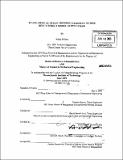Evaluating an ocean shipment strategy within Dell's direct model supply chain
Author(s)
Nelson, Adam (Adam T.)
DownloadFull printable version (9.902Mb)
Other Contributors
Leaders for Manufacturing Program.
Advisor
Stephen C. Graves and David Simchi Levi.
Terms of use
Metadata
Show full item recordAbstract
In 2007, Dell made the decision to make another attempt at selling computers through the retail channel in an effort to stimulate growth. Dell has been extremely successful in the direct channel and they are now trying to adapt their capabilities and their supply chain so they can meet the challenges and requirements of the new distribution channel. Retailers require large orders on specific dates, they want multiple configurations available to them, they want the most competitive prices, and they want to delay purchase commitments as long as possible. Before 2007, Dell had been manufacturing their notebooks in Dell-owned facilities in Asia. They would then fly the notebooks to the Dell merge center in Nashville, TN before shipping them to the retailer distribution centers. Dell has now begun outsourcing much of the notebook manufacturing to manufacturing partners, or contract manufacturers, in Asia and is continuing to look for other ways to cut costs. One opportunity for significant savings is to switch the method of product transportation from air shipment to ocean shipment. There are a number of issues associated with this option so the change needs to be done correctly or all of the savings could be lost due to other costs such as expedites, excess and obsolescent inventory, and retailer penalties. The difference in lead-time between air and ocean shipment is significant. To evaluate the positive and negative effects of an ocean shipment strategy at Dell I explored two specific cases. The first case analyzed involved notebook orders to Dell's largest customer in the retail channel. (cont.) The main concern regarding ocean shipment in the retail channel is the risk of order cancellation while the finished product is on the water. Therefore, the approach I used was to determine a break-even point and what the cancellation risk would have to be for the costs and benefits to cancel each other out. The second case analyzed involved orders to one of Dell's largest commercial customers. This customer was selected because they typically order a standard configuration and because a finished goods inventory is already maintained by a third party to fulfill their orders. This case allowed me to determine how much additional inventory would have to be maintained due to the increase in lead time. These two scenarios cover a variety of products and channel issues, and have applicable lessons to other customers.
Description
Thesis (M.B.A.)--Massachusetts Institute of Technology, Sloan School of Management; and, (S.M.)--Massachusetts Institute of Technology, Dept. of Mechanical Engineering; in conjunction with the Leaders for Manufacturing Program at MIT, 2009. Includes bibliographical references (p. 50-51).
Date issued
2009Department
Leaders for Manufacturing Program at MIT; Massachusetts Institute of Technology. Department of Mechanical Engineering; Sloan School of ManagementPublisher
Massachusetts Institute of Technology
Keywords
Sloan School of Management., Mechanical Engineering., Leaders for Manufacturing Program.